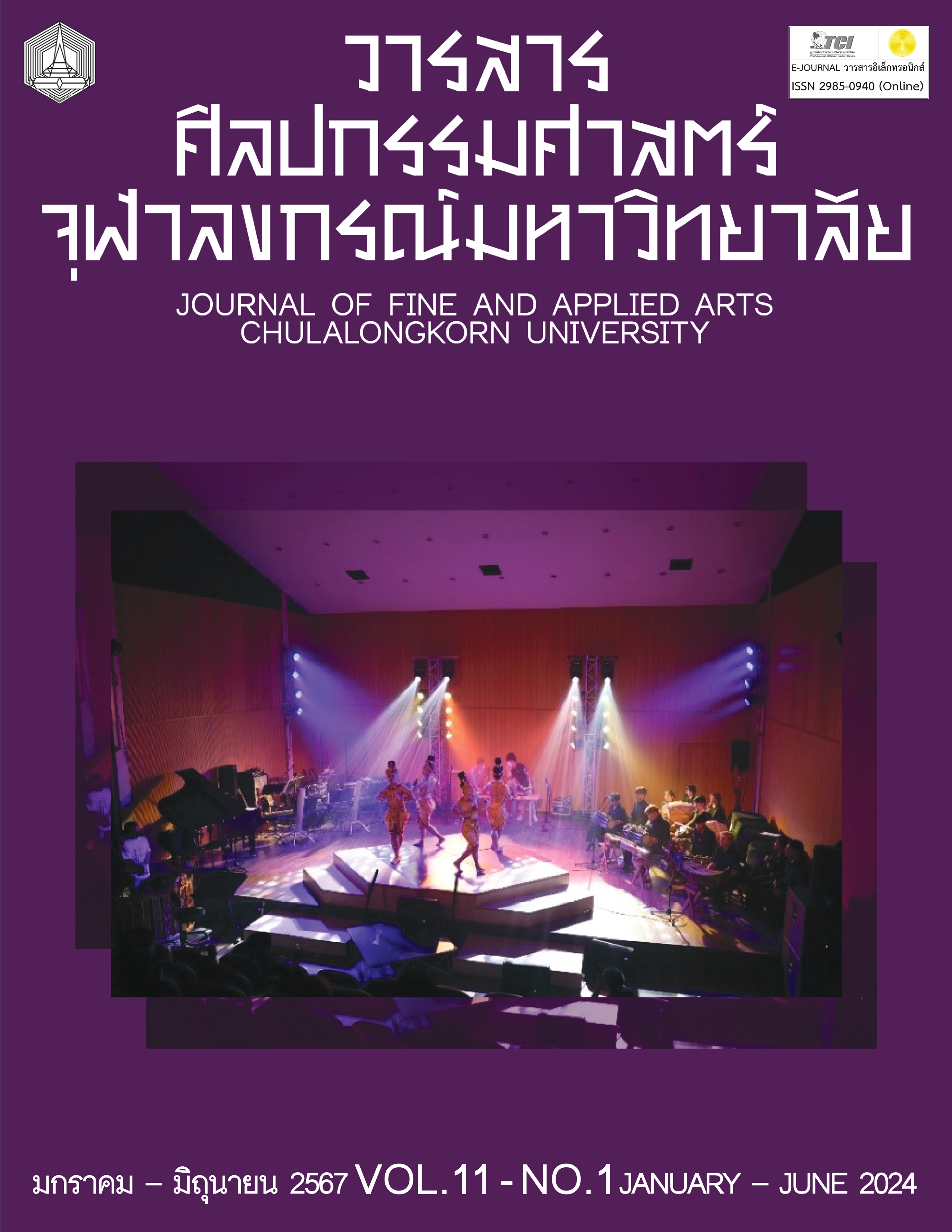PIANO SONATA NO. 14 IN C MINOR, K. 457 BY W. A. MOZART: INTERPRETATION AND PRACTICE STRATEGIES
Keywords:
W. A. Mozart, Piano, Sonata, Interpretation, Practice StrategiesAbstract
The objectives of the thesis, Sonata No.14 in C minor, K. 457 by Mozart: Interpretation and Practice strategies, are to interpret and analyze performance technique, and to present practice strategies. Moreover, the scope of the study includes interpretation and analysis covering 6 performance techniques: melodic presentation, ornament, fingering, dynamics, articulation, and pedaling. Based on the study of performance techniques, the researcher focuses on playing melodic lines clearly. Ornaments are mostly changed on the fingerings differently from the reference edition. Furthermore, the fingerings, in the other places, are changed. The researcher uses dynamics differently from the reference edition in some bars playing decrescendo and crescendo according to the direction of the notes. In the 1st and the 3rd movements, pedaling is added where the notes indicate loud play, while in the 2nd movement, pedaling is added throughout to connect the sounds of melodic and harmonic lines. The section on practice strategies is divided into 8 techniques found in this piece: 1) Arpeggios, practicing as block chord initially and then subsequently playing as written; 2) Ornament, playing with strong fingers and practicing only the ornament part; 3) Hand-crossing, practicing with one hand playing this technique; 4) Scales, focusing on practicing with different
articulations; 5) Playing continual 3rd intervals, practicing with an exercise from Hanon; 6) 2 melodic lines with right hand, memorizing the important melodic part first and later practicing both melodic lines utilizing extra wrist force on important melodic lines; 7) 2 melodic lines with left hand where pedal notes are, playing them carefully and steadily; 8) playing forte, utilizing extra arm force and leaning the body toward the piano.
References
Bree, Malwine. The Leschetizky Method: A Guide to Fine and Correct Piano Playing. New York: Dover Publications, 1997.
Chulapan, Panjai. Piano Literature 1. Bangkok: Chulalongkorn University Press, 2008.
ปานใจ จุฬาพันธุ์. วรรณกรรมเพลงเปียโน 1. กรุงเทพฯ : สำนักพิมพ์แห่งจุฬาลงกรณ์มหาวิทยาลัย, 2551.
Czerny, Carl. Complete Theoretical and Practical Piano Forte School: From the First Rudiment of Playing to the Highest and Most Refined State of Cultivation with the Requisite Numerous Examples Newly and Expressly Composed for the Occasion. Vol.3. Translated by J.A. Hamilton. London: R. Cocks, 1839.
Epstein, Richard, ed. Mozart Nineteen Sonatas for the Piano Book II. New York: G. Schirmer, 1986.
Gieseking, Walter and Leimer, Karl. Piano Technique. Mineola, NY: Dover Publications, 1972.
Leamthong, Apichai. “Principle of Maximum Effective Practicing in Music.” Rangsit Music Journal 7, No.1 (January-June 2012): 29-39.
อภิชัย เลี่ยมทอง. “หลักสําคัญสําหรับการฝึกซ้อมดนตรีเพื่อประสิทธิภาพสูงสุด.” วารสารดนตรีรังสิต มหาวิทยาลัยรังสิต ปีที่ 7, ฉบับที่ 1 (มกราคม – มิถุนายน 2555): 29-39.
Lhevinne, Josef. Basic Principles in Pianoforte Playing. New York: Dover Publications, 1972.
Moschos, Petros. “Performing Classical-Period Music on the Modern Piano.” D.M.A. diss., City University London, 2006.
Mun, Kyoung Ah. “A Performer's Analysis of Fantasia in C Minor, k. 475 and Sonata in C minor, k. 457 by Wolfgang Amadeus Mozart, and Selected Etudes, Nos. 1, 4, 10, and 16 by Gyorgy Sandor Ligeti.” D.M.A. diss., Southwestern Baptist Theological Seminary, 2013.
Pancharoen, Natchar. Music Dictionary. 4th ed. Bangkok: Kedkarat, 2011.
ณัชชา พันธุ์เจริญ. พจนานุกรมศัพท์ดุริยางคศิลป์. พิมพ์ครั้งที่ 4. กรุงเทพฯ : เกศกะรัต, 2554.
Premananda, Weerachat. “Repertoire for Improving Ability for Thai Pianist.” Rangsit Music Journal 5, No. 2 (July-December 2010): 5-19.
วีรชาติ เปรมานนท์. “บทเพลงเพื่อการพัฒนาศักยภาพสำหรับนักเปียโนไทย.” วารสารดนตรีรังสิต ปีที่ 5, ฉบับที่ 2 (กรกฎาคม – ธันวาคม 2553): 7.
Small, Allan, ed. Hanon-the Virtuoso Pianist in 60 Exercises. 2nd ed. Van Nuys, CA: Alfred Publishing, 1992.
Sudasna Na Ayudhya, Julmanee. “Comparative Analysis of Slow Movements in Wolfgang Amadeus Mozart’s and Ludwig Beethoven’s Piano Sonatas.” Humanities Journal 23, No. 2 (July-December 2016): 123-147.
จุฬมณี สุทัศน์ ณ อยุธยา. “การวิเคราะห์เปรียบเทียบท่อนช้าในเปียโนโซนาตาของโวล์ฟกัง อะมาเดอุส โมสาร์ท และลุดวิกฟาน เบโทเฟน.” วารสารมนุษยศาสตร์ ปีที่ 23, ฉบับที่ 2 (กรกฎาคม – ธันวาคม 2559): 123-147.
Suttachitt, Narutt. Music Appreciation in Western Music. 7th ed. Bangkok: Chulalongkorn University Press, 2004.
ณรุทธ์ สุทธจิตต์. สังคีตนิยม : ความซาบซึ้งในดนตรีตะวันตก. พิมพ์ครั้งที่ 7. กรุงเทพ ฯ : สำนักพิมพ์แห่งจุฬาลงกรณ์มหาวิทยาลัย, 2547.
Tanchanpong, Pawalai. Variations in Beethoven’s Piano Repertoire: Performance and Analytical Notes. Bangkok: Thana Press, 2016.
ภาวไล ตันจันทร์พงศ์. บทเพลงทางแปรในวรรณกรรมเปียโนของเบโทเฟน: การแสดงดนตรีพร้อมบทวิเคราะห์. กรุงเทพฯ : ธนาเพรส, 2559.
Tanchanpong, Pawalai. “Variations in Beethoven’s Piano Repertoire: Performance and Analytical Notes.” Rangsit Music Journal 12, No. 2 (July-December 2017): 103-110.
ภาวไล ตันจันทร์พงศ์. “บทประพันธ์เพลงทางแปรในวรรณกรรมเปียโนของเบโทเฟน: การแสดงดนตรีพร้อมบทวิเคราะห์.” วารสารดนตรีรังสิต มหาวิทยาลัยรังสิต ปีที่ 12, ฉบับที่ 2 (กรกฎาคม – ธันวาคม 2560): 103-110.
Wolf, Eugene K. “The Rediscovery Autograph of Mozart's Fantasy and Sonata in C Minor, k. 475/457.” The Journal of Musicology 10, no. 1 (Winter 1992): 3-47.
Downloads
Published
Issue
Section
License
Copyright (c) 2024 วรรณอนงค์ จันทร์อ่อน, วิบูลย์ ตระกูลฮุ้น

This work is licensed under a Creative Commons Attribution-NonCommercial-NoDerivatives 4.0 International License.
ลิขสิทธิ์ของบทความเป็นของเจ้าของบทความ บทความที่ได้รับการตีพิมพ์ถือเป็นทัศนะของผู้เขียน
กองบรรณาธิการไม่จำเป็นต้องเห็นด้วยและไม่รับผิดชอบต่อบทความนั้น






